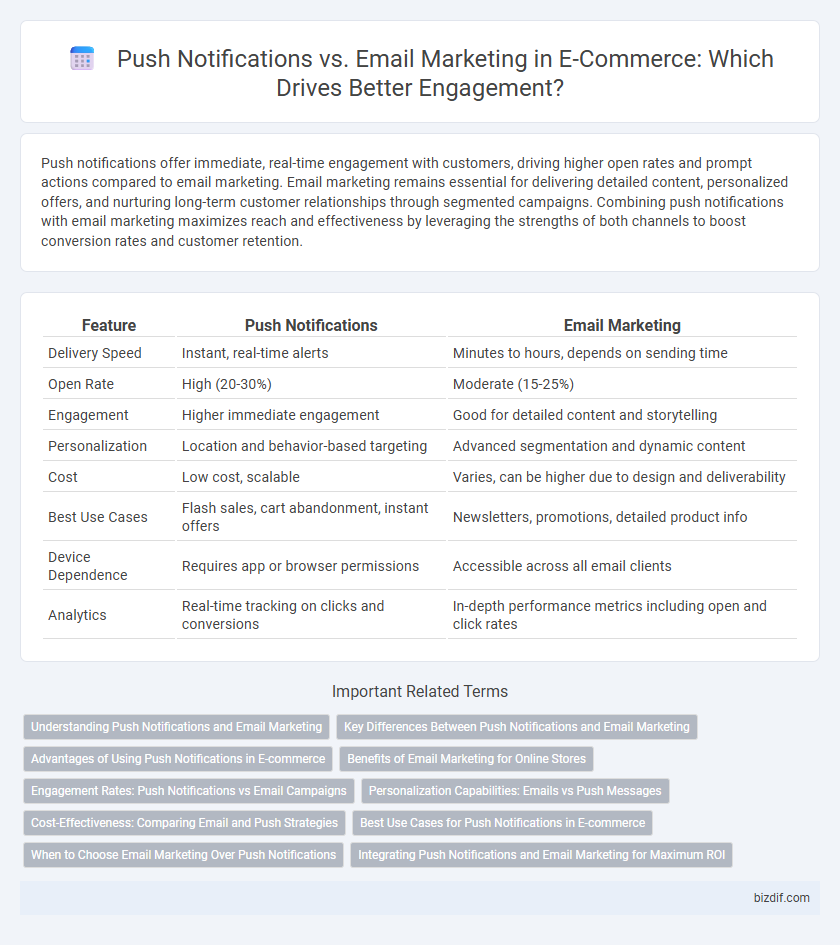Push notifications offer immediate, real-time engagement with customers, driving higher open rates and prompt actions compared to email marketing. Email marketing remains essential for delivering detailed content, personalized offers, and nurturing long-term customer relationships through segmented campaigns. Combining push notifications with email marketing maximizes reach and effectiveness by leveraging the strengths of both channels to boost conversion rates and customer retention.
Table of Comparison
| Feature | Push Notifications | Email Marketing |
|---|---|---|
| Delivery Speed | Instant, real-time alerts | Minutes to hours, depends on sending time |
| Open Rate | High (20-30%) | Moderate (15-25%) |
| Engagement | Higher immediate engagement | Good for detailed content and storytelling |
| Personalization | Location and behavior-based targeting | Advanced segmentation and dynamic content |
| Cost | Low cost, scalable | Varies, can be higher due to design and deliverability |
| Best Use Cases | Flash sales, cart abandonment, instant offers | Newsletters, promotions, detailed product info |
| Device Dependence | Requires app or browser permissions | Accessible across all email clients |
| Analytics | Real-time tracking on clicks and conversions | In-depth performance metrics including open and click rates |
Understanding Push Notifications and Email Marketing
Push notifications deliver instant, concise messages directly to users' devices, driving immediate engagement with personalized offers and updates. Email marketing provides a versatile platform for detailed content, nurturing customer relationships through newsletters, promotions, and targeted campaigns. Both channels enhance e-commerce strategies by combining immediacy with depth for optimized customer communication.
Key Differences Between Push Notifications and Email Marketing
Push notifications deliver instant, concise messages directly to a user's device, enabling real-time engagement, whereas email marketing allows for longer, more detailed content with rich media and personalization. Push notifications typically achieve higher open rates due to their immediacy but are limited in content complexity, while email campaigns excel in nurturing customer relationships through segmented targeting and comprehensive storytelling. The cost-effectiveness and frequency of push notifications contrast with the broader reach and versatility of email marketing, making each channel suitable for different stages of the e-commerce customer journey.
Advantages of Using Push Notifications in E-commerce
Push notifications in e-commerce offer real-time engagement with customers, leading to higher click-through rates compared to email marketing. These notifications provide instant, personalized updates on promotions or cart reminders, enhancing customer retention and driving immediate sales. Push notifications also reduce the risk of landing in spam folders, ensuring direct communication and improved conversion rates.
Benefits of Email Marketing for Online Stores
Email marketing drives higher ROI by enabling personalized promotions and targeted segmentation, which boosts customer engagement and repeat purchases for online stores. It offers cost-effective automation tools that streamline communication, ensuring timely delivery of tailored offers and cart abandonment reminders. Detailed analytics from email campaigns allow e-commerce businesses to optimize strategies based on open rates, click-through rates, and conversion metrics.
Engagement Rates: Push Notifications vs Email Campaigns
Push notifications deliver engagement rates up to 10 times higher than email campaigns, with average click-through rates (CTR) ranging from 6% to 8% compared to email's 1% to 3%. Real-time delivery and personalized content in push notifications drive instant user interaction, boosting conversion rates for e-commerce businesses. Email marketing maintains value in nurturing leads with detailed content, but push notifications excel in immediate customer reactivation and time-sensitive promotions.
Personalization Capabilities: Emails vs Push Messages
Email marketing offers extensive personalization capabilities, allowing e-commerce brands to tailor content based on customer behavior, purchase history, and preferences, resulting in highly targeted promotions. Push notifications provide real-time, location-based personalization but are limited by shorter content formats and less detailed customer data compared to emails. Combining both channels enhances reach and engagement by leveraging the depth of email personalization with the immediacy of push messages.
Cost-Effectiveness: Comparing Email and Push Strategies
Push notifications offer higher cost-effectiveness for e-commerce by delivering instant, targeted messages with minimal expenses compared to email marketing, which often incurs higher costs related to design, content creation, and email platform fees. Email marketing provides a broader reach and greater customization options but typically shows lower engagement rates and slower conversion times. Analyzing ROI, push notifications yield faster customer interaction, whereas email campaigns require investment in segmentation and testing to maximize cost efficiency.
Best Use Cases for Push Notifications in E-commerce
Push notifications excel in e-commerce for time-sensitive promotions, flash sales, and personalized product recommendations, driving immediate customer engagement and boosting conversion rates. Their real-time delivery and high visibility make them ideal for cart abandonment reminders and timely updates on order status or exclusive deals. Compared to email marketing, push notifications offer higher open rates and quicker interaction, enhancing customer retention and fostering repeat purchases.
When to Choose Email Marketing Over Push Notifications
Email marketing is more effective for delivering detailed content such as promotional newsletters, product updates, and personalized offers that require thoughtful engagement. It is ideal for high-value campaigns targeting customer retention, segmentation, and nurturing leads over time with rich visuals and links. Use email when aiming to build long-term relationships and provide comprehensive information that push notifications, limited by brevity, cannot convey.
Integrating Push Notifications and Email Marketing for Maximum ROI
Integrating push notifications and email marketing in e-commerce campaigns significantly enhances customer engagement and conversion rates by leveraging the immediacy of push alerts with the detailed content of emails. Synchronizing timing, messaging, and customer segmentation across both channels boosts ROI through consistent and personalized communication. Analyzing performance metrics such as open rates, click-through rates, and conversion data enables continuous optimization of integrated marketing strategies.
Push Notifications vs Email Marketing Infographic

 bizdif.com
bizdif.com